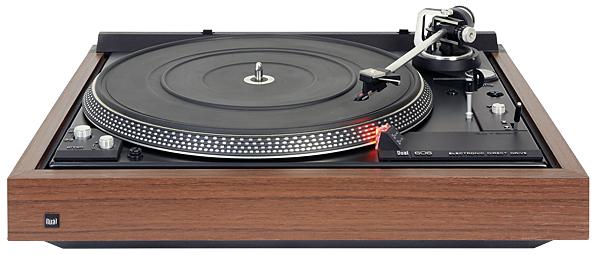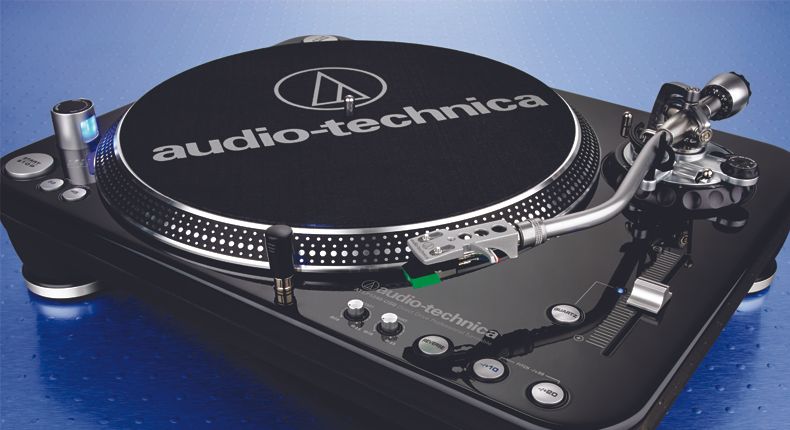It’s difficult to overstate the decline of Dual, which had once been one of Europe’s leading turntable manufacturers, employing over three thousand people across various factories in West Germany during the country’s postwar economic boom. It originated in 1907 in the Black Forest village of St. Georgen, when brothers Christian and Joseph Steidinger began creating clockwork and gramophone parts. Dual became a brand name for Gebrüder Steidinger (Steidinger Brothers) in 1927. It was a reference to the company’s dual-mode power supplies, which allowed other firms’ turntables to be powered by either AC mains or a clockwork wind-up mechanism. The company soon began producing its own record players.
Dual finally got its act together in 1979. Prior to this, it had manufactured a series of somewhat ungainly-looking turntables throughout the 1970s, lacking the visual sophistication and operational slickness of, say, Technics products. The CS504 was a reasonably successful machine; it was a good lower-mid-priced machine that was belt powered and made a lovely sound. Although it was noticeably better-looking than the deck it replaced, it fell short of the more sleek and sophisticated Japanese competitors. The new 2006 collection was thinner, less bulky, and featured a gentler, more sensitive motion. At the same time, they introduced a notion known as ‘Ultra Low Mass,’ which Dual coined. This, the business hoped, would be the final nail in the coffin, giving the new range a unique selling proposition that would set it apart from its competitors.
The CS506 and CS606 were first shown in the United Kingdom at the Harrogate show in 1980. Dual’s buzzword was ‘ULM,’ and it impressed a lot of people. The very low mass of both the arm and the new generation of Ortofon-made cartridges looked like an amazing combo, compared to the previous generation of decks, which had medium mass tonearms. Dual claimed that it allowed turntables to ride warps better, which was something that vinyl users were becoming increasingly concerned about as pressing quality declined and LPs became thinner and lighter. Indeed, the quality of new LP records had deteriorated; they were thirty or so grams lighter than a decade earlier, and the use of recycled vinyl was becoming more common.
Of fact, low mass was nothing new. The shift from high effective mass guns and low compliance cartridges to the exact opposite was a hallmark of the 1970s. Shure and Grado moving magnet cartridges with lowish mass and great compliance became extremely popular in the second half of the decade. Indeed, the SME Series III tonearm epitomized this tendency, with a low effective mass high-end arm designed to take advantage of it. Dual was actually a little late to the party, as the trend was shifting back to large mass arms and low compliance moving coils. Regardless, ULM was a concept that the general public understood and that was easier to market to more mainstream purchasers who believed that lighter was certainly better when it came to record playing.
Dual appeared to have finally found a winning combination of high-end and mid-range turntables. The CS506 went on to become a tremendous sales success; at £115, it was inexpensive and appeared to be extremely well crafted for the price. The new ULM turntables were available in both belt and direct drive versions, with the CS506 being the entry-level belt drive and the £150 CS606 being the mid-priced direct drive. Both possessed Dual’s basic end-of-side auto-return, which was controlled by a microswitch to avoid interfering with the tonearm’s operation. This was a good balance between totally manual decks like the Rega Planar 3 and fully automatic Japanese designs like Pioneer’s PL-600, which were more mechanically sophisticated and, as a result, significantly compromised.
The CS606 that you see here has electronically regulated direct drive, which was extremely popular in the lower to mid market at the time. Dual’s EDS 500 direct drive technology provided the CS506’s superb fundamental mechanicals a big boost. Wow and flutter were down to 0.03 percent WRMS, which was admirably low and comparable to the greatest Japanese direct drives of the day. The speeds were the standard 33.33 and 45rpm, plus a 10% pitch adjustment for home musicians who wanted to play along. A 1.4kg, 304mm non-magnetic aluminium platter with a good rubber mat was installed. Rumble was estimated to be -75dB, which was an excellent value at the time.
That sleek new ULM tubular aluminium tonearm – effective length 221mm – was engineered to track at very low weights and had well-set up bearings. The business rejected the then-dominant Shure cartridges in favor of something more familiar, including an Ortofon ULM55E moving magnet that was engineered to perfectly complement the tonearm. It also featured the firm’s proprietary resonance reducer. It was mounted on a black-painted pressed steel chassis with springs decoupling it from the wood base. The cartridge’s biradial DN155E stylus tracks at 1.25 to 1.75 grams, with 1.5 grams being recommended. It features a frequency response of 10Hz to 25kHz and a reasonable output of 0.7mV for a cartridge of its age. It has a total mass of under 2.5g, which means it can ride warps very effectively when used with the ULM tonearm.
It’s astonishing how well this sounds when properly set up, on a level surface, and with the dustcover removed. It competed with a wide range of Japanese rivals at the time, many of which had a slightly glossy sound that may become brittle at times. On the bright side, they were vibrant and interesting to listen to, but this could grate over time. The Dual has a very different personality than this, and it sounds more like a belt drive in some ways. This means it isn’t hard-edged, forward, or mechanical; instead, it has a natural musical flow that is quite enjoyable to listen to. At the same time, it is tonally warmer than many of its contemporaries, resulting in a lovely and mellifluous performance.
Of course, a lot relies on the type of cartridge used. The regular Ortofon device is fine, but it has a little opaque, hazy, and distant quality to it. Things get even better when you put a Shure V15/IV in it – admittedly overkill given that it cost more than the deck at the time. The music becomes much more lively and emotionally charged as a result of the increased precision. With a decent stereo soundstage and pictures held firmly in space inside the mix, the bass is taut and the treble is sharp. In the grand scheme of things, this isn’t a Linn Sondek competitor, but it is a step up over the Rega Planar 3 and similar models. It’s interesting that it didn’t sell in large numbers in the UK, with only the more affordable CS506 selling in significant numbers.
Only a few years after its debut, the 2006 collection was discreetly discontinued. The new Dual CS505, which was basically a stripped-down, price-cut CS506 selling – at first – for just £59.95 in the UK, was proving highly popular. Even though the strobe symbols on the platter were kept, it lost the actual wood plinth and stroboscope light of its bigger sibling. Because it was a third of the price of a Rega Planar 2, it quickly became the ‘budget audiophile’ weapon of choice for a generation of aspiring Linn Sondek owners. Later decks were dubbed the CS505/Improved, and they had an improved headshell that did away with Dual’s finicky cartridge carrier system, as well as a redesigned plinth and a better turntable mat. This pushed the price up to £109.95, dangerously close to the Rega and the original CS506 – both of which had been quietly discontinued by this point.
Despite the fact that Dual’s CS505 became a huge seller in the cash-strapped UK market, the company went bankrupt in 1982 and was acquired to Thomson SA, a French electronic manufacturer. Thomson sold Dual to Schneider Rundfunkwerke AG of Germany in 1988. The company was divided as Dual Phono GmbH in 1993, and this is still the case today. Meanwhile, Dual DGC GmbH (Germany) offers turntables in Europe under its own brand of Far East-sourced consumer equipment. To add to the mystery, the brand name reappeared in the Americas, owned by a South Korean corporation that also sells consumer electronics. In reality, Dual’s golden years were the late 1970s and early 1980s, and the CS606 is a fitting tribute to those years.
A used Dual is a safer bet than many others because it is mechanically simple. The great quality of their production adds to their case. The bearings are in good shape, the electronics are stable, and the tonearms are durable – but no turntable can endure an uncaring owner, so potential buyers should pay attention to the condition. Check for sloppy tonearm bearings, speed instabilities, and motor mechanical sounds. If a cartridge is installed, inspect the stylus under a microscope if possible. Purchase a boxed example if possible, as it will have been properly transported over the years. If you find a good example, you’ll have a basic, easy-to-use, and dependable record player that should last for decades and produce great sound.






